
The name of T.A. Coward will be familiar to anyone from
Cheshire with anything more than a passing interest in the wildlife of the
County, especially it's avifauna. Born in Bowdon near Altrincham in 1867 Thomas
Alfred Coward was educated at Brooklands School Sale and Owens College
Manchester, and for nineteen years worked for Messrs. Melland and Coward, a
firm of bleachers and finishers who were eventually absorbed by another,
larger Coward spent all his life in Cheshire and served his apprenticeship in the woods and moorlands and around the meres that are still so familiar to the County's birders and in 1900 his first book "The Birds of Cheshire" was published. This was written jointly with Charles Oldham (1868 - 1942) who was educated at the same school in Manchester, the two becoming lifelong friends and colleagues. Oldham provides a further local link with Knutsford as he actually lived in the town for some years before his work took him south in 1907, working in London and setting up home in Hertfordshire. The "Birds of Cheshire" was the first comprehensive account of the county's birds and the authors had access to very little historical data for reference when attempting to determine population changes over the years, as a consequence the book has itself become the earliest "benchmark" available, numerous references are made to it in "The Breeding Bird Atlas of Cheshire and Wirral" published in 1992. Although the status of each species as judged by the two authors is given, no tables showing locations, dates and counts are used, instead much of the book is given over to notes about the behavior and field characteristics of selected species they had become familiar with during their formative years in the field. In 1910 the pair again collaborated in the production of a more ambitious work " The Vertebrate Fauna of Cheshire and Liverpool Bay" covering mammals, birds, reptiles, amphibians and fishes, the section on fishes being written by James Johnstone. Although some of the text in section on birds was taken from their first book there was much additional material based on their personal observations. Oldham went on to enhance his reputation as an authoritative figure in British ornithological circles, contributing the field characteristics for most of the species included in "The Practical Handbook of British Birds" - 2 vols (bound in 3). 1920, published by Witherby & Co. and spending much time and care checking the proofs of some sections of "The Handbook of British Birds" - 5 vols. 1938 - 41 published by Witherby and Co. He served on the committee of the British Ornithological Union, 1926 - 29 and was Vice-President 1936 - 38. Coward meanwhile continued with his fieldwork
travelling widely within the British Isles, extended trips were made to Wales and Scotland (even out as far as St. Kilda) gathering material for his
magnum opus "The Birds
Further books followed, "Bird Haunts and Nature Memories" (1922), "Life of the Wayside & Woodland" (1923),"Birds and Their Young" (1923), "Bird Life at Home and Abroad" (1927), "Bird and Other Nature Problems" (1931) plus two books about his home County "Cheshire - Traditions and History" (1932) and a revised edition of his 1903 book "Picturesque Cheshire" (1926). Thomas Coward died suddenly at his home, Brentwood, Grange Road, Bowdon on the 29th. January 1933 he was 66 years of age. Over the years he had contributed articles to many newspapers and magazines and numerous obituaries were published, in Ibis Charles Oldham wrote of "a lovable man, upright, sincere, and overflowing with the milk of human kindness." Another, in the Manchester Guardian contained an amusing paragraph "He occupied the end seat of the end pew, and I have always supposed he chose it to enable him to slip out easily if he heard a particularly attractive bird call, without disturbing the congregation." Shortly after his death a Memorial Fund was set up and donations were received from all over the World including Canada, Australia, India, the USA and China, £900 was raised, a not inconsiderable sum at the time (in the same copy of the Alderley and Wilmslow Advertiser that this information came from I noticed a 3 bed semi in Bramhall for £550 and a 3 bed detached in Davenport for £850!) The money subscribed was used to buy and set aside as nature reserves for all time the whole of Cotterill Clough near Ringway and the Marbury reed bed at Budworth Mere. So Coward's legacy to us are his books, they will be
around in one form or another for many generations to come, but what of the raw
materials from which he crafted the final product - the years of
Consider now the average Cheshire bird watcher's notebook, we're looking at something of A6 size or less, perhaps loose leaf and certainly dog-eared, tea or coffee stained and filled with barely decipherable hieroglyphics pertaining to a recent wildfowl count on a freezing windswept day from the Dee estuary or one of the Cheshire Meres. These may or may not be transferred later to a larger format who's dimensions are determined by what was to hand when the boss wasn't looking! I was quite unprepared for what awaited me in Oxford. Dr. Birch had kindly removed the books prior to my arrival and had set them out on a small table for my perusal, it was sagging in the middle! To say they were bigger than expected would be an understatement, each volume was bigger than A4, probably foolscap folio (13.5" X 8.5") and at least 2" thick. For most years the records were bound into a single volume, some years were so large that they merited a separate bound index. The early years from 1883 to 1889 were condensed into a single volume, starting when Coward was 17 years old and would appear to have been copied from other documentation. The most remarkable feature of Coward's field notes was that every page was typewritten, from 1st. January 1883 until the last entry 50 years later on the 20th. January 1933 only 9 days before his death. Additionally the names of every species was typed both in English and Latin, I found such self discipline and single-mindedness quite remarkable. Fortunately Coward wasn't a "lister" and no
attempt was made to record every species seen nor were wildfowl counts made on
a regular basis, instead the notebooks consist of detailed observations,
chiefly identification features and behaviour. These were typed up some time
after the event as clippings from the various newspapers to which he
contributed were pasted onto the same pages as the original observations used
as a basis for that particular article.
There weren't any fieldguides available in the late 19th. century when Thomas Coward first began to take an interest in natural history, there was "A History of British Birds" by William Yarrell illustrated with wood engravings or William MacGillivray's "A manual of British ornithology" which gave descriptions of species but had few illustrations, neither of these would have been much use in the field and many youngsters must have been discouraged by a lack of helpful publications to help get them started. Perhaps it was his early experiences that gave him the idea of producing a well illustrated and manageable guide aimed at the general public that lead eventually to the production of "The Birds of the British Isles and Their Eggs". Early entries in his field notes illustrate the problems the young Coward had with identification - in 1884 he was struggling with reliably identifying Black Headed Gulls in winter plumage, Goldeneyes and even Great Spotted Woodpecker also caused some confusion! If you couldn't take the book to the bird then the bird had to be taken to the book and so, like most other naturalists of the day, Coward resorted to shooting birds in order to examine them in greater detail. Locally Little Grebe, Long Tailed Tit, Linnet, Meadow Pipit and others all paid the ultimate price in the interests of science whilst a trip to Scotland accounted for Redshank, Rock Dove and Shag. Today's politically correct bunny-huggers wouldn't be impressed with this approach but it was perfectly acceptable at the time. All Coward's obituaries talk of his dislike for blood sports and killing for killing's sake, perhaps his books went some way to alleviating the need of others who followed to use such extreme methods. Unfortunately I only had a limited amount of time in the Library and had to move quickly on to the final volumes, via one or two specific dates that I had identified prior to my visit as being of particular interest. Looking at the 1932 volume it is apparent that Coward's enthusiasm had not diminished at all and he was still out in the field three of four times a week, conscientiously updating his field notes after each outing. It was clear that by now he had become something of a celebrity, he was much in demand as a lecturer and his notes by now are accompanied by numerous letters from across the length and breadth of the UK and beyond, with queries or on-going correspondence about natural history matters in general, but ornithology in particular. In November 1932 I counted no less than ten different lectures given to audiences across Manchester, Cheshire and Derbyshire, amongst the titles were "Birds and Their Food", "Episodes of Animal Life", Birds and Insects", "Old Buildings of Cheshire" and a presentation entitled "Whales and Whaling" given to 250 boys and girls at Chadderton Grammar School. They must have had a different attention span in those days, it would be a brave man to attempt a feat like that nowadays! On the 29th the notebook refers to a broadcast - "Amongst our Northern Birds in Autumn" in those days this would no doubt have been "live" but there's just the possibility a recording was made of one of these broadcasts - another job for Google perhaps! The last entry in Coward's notebook for 1933 appropriately details a trip round Tatton Park with his friend Thomas Baddeley on January 20th, he died nine days later and was cremated on February 1st. at Manchester Crematorium, a memorial service being held later at Bowdon Downs Congregational Church. Amongst the multitude of tributes published in a variety of newspapers and journals was one from the "Altrincham Guardian" by A.K. Lawson which included the paragraph "The books he has left us will prove a source of delight to future generations, as they have been to us, and his scientific achievements will stand for ever as a monument to one of Nature's finest gentlemen" The World would be a much better place if we could all be remembered by a tribute such as that. |
| My thanks go to Dr. Linda
Birch and her staff in the Alexander Library for allowing me to examine
Coward's Field Notes and for their hospitality during my visit. The library
contains one of the biggest collections of ornithological material in the
world, currently holding 10,700 books, 85,000 reprints, 476 theses, 590 current
serials and 1,300 non-current serials. Further details can be obtained from Dr. Birch at Edward Grey Institute of Field Ornithology, Department of Zoology South Parks Road, Oxford OX1 3PS tel. 01865 271275 e-mail linda.birch@zoo.ox.ac.uk Website is at http://users.ox.ac.uk/~zoolib/alexarchive.htm |
|
 |
|
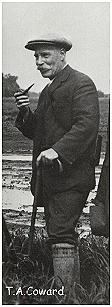 organisation, The
Bleachers Combine. This gave Coward the opportunity to retire from business and
for the next thirty years he was able to devote himself entirely to the pursuit
of natural history and become acknowledged as one of the most accomplished,
all-round practical field naturalists this Country has ever produced. His most
famous work, "The Birds of the British Isles and Their Eggs"
published in 1920 was acknowledged as being the book that did more to
popularise the study of birds than any other publication produced during the
first part of the twentieth century.
organisation, The
Bleachers Combine. This gave Coward the opportunity to retire from business and
for the next thirty years he was able to devote himself entirely to the pursuit
of natural history and become acknowledged as one of the most accomplished,
all-round practical field naturalists this Country has ever produced. His most
famous work, "The Birds of the British Isles and Their Eggs"
published in 1920 was acknowledged as being the book that did more to
popularise the study of birds than any other publication produced during the
first part of the twentieth century. 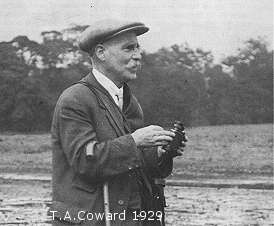 of the British Isles
and their Eggs" published by Frederick Warne & Co. Ltd. - 2 vols
(series I & II). 1920 : 3vols from 1926 - this third volume (series III)
dealt in greater detail with nomenclature, migration and seasonal movements.
Measuring only c. 130mm X 175mm (5" X 7") these three attractive
books, bound in brown mock-leather cloth with black and gold gilt embossed
lettering and small vignettes were printed by the thousand and a complete set
can still be obtained for less than £50. Although the sections devoted to
nomenclature and migration are probably no longer entirely relevant all three
volumes are a pleasure to read, there are no dry pages of graphs, charts and
those silly sonagrams that are found in BWP instead Coward uses his immense
knowledge and writing skill to guide the reader through our avifauna in a
simple language, devoid of technicalities but in a characteristically
authoritative and accurate manner that was a hallmark of all his work.
of the British Isles
and their Eggs" published by Frederick Warne & Co. Ltd. - 2 vols
(series I & II). 1920 : 3vols from 1926 - this third volume (series III)
dealt in greater detail with nomenclature, migration and seasonal movements.
Measuring only c. 130mm X 175mm (5" X 7") these three attractive
books, bound in brown mock-leather cloth with black and gold gilt embossed
lettering and small vignettes were printed by the thousand and a complete set
can still be obtained for less than £50. Although the sections devoted to
nomenclature and migration are probably no longer entirely relevant all three
volumes are a pleasure to read, there are no dry pages of graphs, charts and
those silly sonagrams that are found in BWP instead Coward uses his immense
knowledge and writing skill to guide the reader through our avifauna in a
simple language, devoid of technicalities but in a characteristically
authoritative and accurate manner that was a hallmark of all his work.
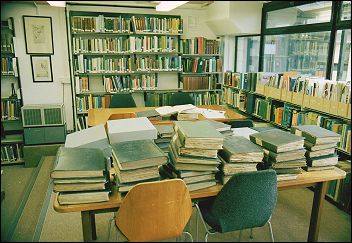 personal observations that he
drew upon and distilled down in such a skillful manner? The books were merely
the tip of the iceberg, somewhere were his field notes, 50 years of them, what
became of this treasure trove? It was Bob Groom, a fellow member of the
Knutsford Ornithological Society who introduced me to Coward's work and
encouraged me to attend my first Book Fair (and subsequently spend too much
hard earned cash!), Bob is a world renowned expert on American Blues Music and
knows the value of retaining for posterity as much original material as
possible in whatever form it exists. I think it was Bob who first posed the
question "I wonder whatever happened to Coward's notebooks?" We
decided that either someone would realise their significance and value and
ensure their safe retention for others to enjoy in years to come or Mrs. Coward
had a clean out after her husband's demise and consigned them to the dustbin!
All my enquiries came to nothing and it appeared that perhaps option two had
been adopted, but then along came technology in the form of the Internet and in
particular
personal observations that he
drew upon and distilled down in such a skillful manner? The books were merely
the tip of the iceberg, somewhere were his field notes, 50 years of them, what
became of this treasure trove? It was Bob Groom, a fellow member of the
Knutsford Ornithological Society who introduced me to Coward's work and
encouraged me to attend my first Book Fair (and subsequently spend too much
hard earned cash!), Bob is a world renowned expert on American Blues Music and
knows the value of retaining for posterity as much original material as
possible in whatever form it exists. I think it was Bob who first posed the
question "I wonder whatever happened to Coward's notebooks?" We
decided that either someone would realise their significance and value and
ensure their safe retention for others to enjoy in years to come or Mrs. Coward
had a clean out after her husband's demise and consigned them to the dustbin!
All my enquiries came to nothing and it appeared that perhaps option two had
been adopted, but then along came technology in the form of the Internet and in
particular 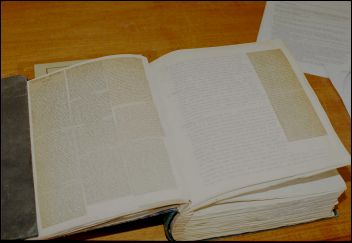
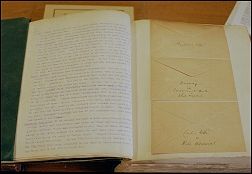 Coward contributed articles on a
regular basis to a number of newspapers, the earliest I found were from 1900
when he was writing a daily "Country Lovers Diary" for the Manchester
Guardian, these were not signed but by 1909 the familiar initials TAC were
appended to the daily "A Country Diary". He continued with this
column until his death when A.W. Boyd took over and continued the good work for
many years after. Selected articles by Boyd are contained in his book "The
Country Diary of a Cheshire Man" and at around £10 essential reading
for all Cheshire birders. Coward's articles in the Liverpool Daily Post
entitled "Nature Notes" were appended FZS but he reverted to TAC for
"Natural History Notes" that appeared in the Chester Cournant. As his
reputation grew so did the amount of correspondence received from both the
general public and fellow ornithologists many of these were added to the
notebooks, although much correspondence is retained in separate boxes.
Coward contributed articles on a
regular basis to a number of newspapers, the earliest I found were from 1900
when he was writing a daily "Country Lovers Diary" for the Manchester
Guardian, these were not signed but by 1909 the familiar initials TAC were
appended to the daily "A Country Diary". He continued with this
column until his death when A.W. Boyd took over and continued the good work for
many years after. Selected articles by Boyd are contained in his book "The
Country Diary of a Cheshire Man" and at around £10 essential reading
for all Cheshire birders. Coward's articles in the Liverpool Daily Post
entitled "Nature Notes" were appended FZS but he reverted to TAC for
"Natural History Notes" that appeared in the Chester Cournant. As his
reputation grew so did the amount of correspondence received from both the
general public and fellow ornithologists many of these were added to the
notebooks, although much correspondence is retained in separate boxes.